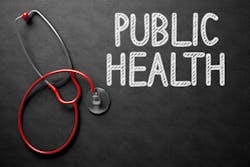During the August 17 meeting of the Health IT Advisory Committee (HITAC), whose work is sponsored by the Office of the National Coordinator for Health IT (ONC), National Coordinator for Health IT Micky Tripathi, Ph.D. laid out some of the goals of the Public Health Data Systems Task Force 2022, whose mission is to build on recommendations from previous HITAC public health-focused tasks forces to inform ONC’s continued collaborative work with the Centers for Disease Control and Prevention (CDC) on improving public health data systems, and to support the CDC’s Data Modernization Initiative (DMI) efforts.
As noted on the CDC’s website, “CDC’s Data Modernization Initiative (DMI) is a multi-year, billion-plus dollar effort to modernize core data and surveillance infrastructure across the federal and state public health landscape.
In his presentation, whose text can be found here, Tripathi made a number of points, including that the COVID-19 pandemic “has affirmed what was an already growing consensus that we need a new approach to nationwide public health surveillance and data systems.”
Key elements of that strategy include:
Ø An enterprise approach to public health architecture
Ø Data-sharing in multiple directions
Ø Common data pillars
Ø End-to-end privacy and security protection
Ø Aligned policy and governance
Further, under the heading “Vision and Strategic Objective for Unified Public Health Data System,” Tripathi cited the following:
Vision: A federated public health ecosystem that can act as one public health community working together to predict, prevent, detect, and respond to public health threats faster and more effectively than ever before
Objective: A unified public health information framework that can rapidly and efficiently share, aggregate, link, curate, and analyze data to produce actionable decision insights that inform local, state, and national public health situational awareness, decision-making, and interventions
ONC certification in this area, Tripathi told those in attendance, addresses key health IT market gaps.
“ONC voluntary certification now covers 800+ health IT products used by 97 percent of hospitals and over 80 percent of physician offices and required by numerous federal programs. Health IT systems are regularly certified to keep pace with advances in medicine, technology, and policy,” his presentation states.
And, in that context, certification:
Ø Establishes baseline technical capabilities for data capture, key functions, and interoperability
Ø Promotes the exchange of electronic health information Establishes baseline privacy and security requirements Increases transparency in the functionality and use of certified health IT
Ø Establishes baseline privacy and security requirements
Ø Increases transparency in the functionality and use of certified health IT
Ø Promotes competition and choice in health IT
Ø Provides baseline assurance that a health IT module will perform clinical care and data exchange functions in accordance with interoperability standards and user-centered design
Ø Establishes accountability of health IT developers to enable ONC to support provider needs and issues
Further, he said, “Certification of EHRs has had positive effects that benefit providers, patients, developers… and PHAs.”
In that regard, it leads to the following:
Ø More mature and effective marketplace of higher capability systems
Ø Rapidly expanded exchange of electronic health information across a variety of methods and platforms
Ø Higher safety and security of health IT infrastructure for patients and healthcare providers
Ø Increase in health IT adoption across the healthcare continuum
Tripathi presented a slide entitled “Certification for Public Health: Initial Ideas for Discussion.” On it were the following points:
Ø Current public health criteria focus on provider systems’ capacity to:
Ø Generate a report according to specific HL7 standards
Ø Transmit a report
Ø Building off of prior HITAC PHDS TF recommendations, ONC and CDC are exploring potential complementary public health criteria for PHA systems that could complete the transaction loop through standards-based functionalities.
Key considerations include the following:
Ø Certification applies to technology modules, not to public health agencies or technology users
Ø Not all capabilities need to be certified, and not all capabilities need to have conformance testing
Ø The process will be gradual and collaborative
A key element in Tripathi’s presentation was the following slide, entitled “Public Health Data Systems Task Force 2022.” It included the following information:
“Overarching Charge: The Public Health Data Systems Task Force 2022 will build upon recommendations from previous HITAC public health-focused task forces to inform ONC’s continued collaborative work with CDC on improving public health data systems, and in support of CDC’s greater Data Modernization Initiative (DMI) efforts.
Specific Charge:
The Public Health Data Systems Task Force 2022 shall examine existing public health certification criterion, known as the ‘(f) criteria in the ONC Health IT Certification Program, certifying the transmission of data to public health agencies to:
1. Identify gaps in the functionalities and standards included in existing (f) criteria, including gaps in 1) functionality, and 2) implementation by developers. Provide recommendations advancing criteria, testing guidance, and/or standards to address gaps.
2. Assess the specific functions (e.g., receipt of data, ingestion of data, analysis of data) supported by public health data systems that would benefit from further standardization and potential certification.
3. Recommend which data flows, aligned with existing (f) criteria, should be prioritized for standardized receipt of data.”
And the final substantive slide in the slide deck, on the “Public Health Data Systems Task Force 2022 Timeline,” included a graphic indicating that the HITAC vote on draft recommendations is scheduled to take place on November 10, with 11 Task Force Meetings planned during calendar year 2022.
Changes at the CDC
All of this comes at a time of some upheaval for the CDC. As The New York Times’s Sharon LaFraniere reported on Wednesday morning
, “Dr. Rochelle P. Walensky, the director of the Centers for Disease Control and Prevention, on Wednesday delivered a sweeping rebuke of her agency’s handling of the coronavirus pandemic, saying it had failed to respond quickly enough and needed to be overhauled. In a meeting with senior staff, Dr. Walensky outlined in broad terms a plan to reorganize the agency’s structure to prioritize public health needs and efforts to curb continuing outbreaks, and to put less emphasis on publication of scientific papers about rare diseases.”
Indeed, LaFraniere wrote, “The steps announced on Wednesday grew out of an external review Dr. Walensky had ordered in April, after months of scathing criticism of the C.D.C.’s response to the pandemic. Its public messages on masking and other mitigation measures were sometimes so confusing or abruptly modified that they seemed more like internal drafts than carefully considered proclamations. The public guidance has been “confusing and overwhelming,” according to a briefing document provided by the agency.”
Meanwhile, CNN’s Brenda Goodman wrote on Wednesday that “Big changes are coming to the United States Centers for Disease Control and Prevention, which recently celebrated its 75th anniversary as the nation’s lead public health agency. CDC director Dr. Rochelle Walensky met with senior leadership at the agency this morning to lay out her plans for overhauling how the agency works. She plans to remake the culture to help the agency move faster when it responds to a public health crisis. She also wants to make it easier for other parts of the government to work with the CDC, and wants to simplify and streamline the website to get rid of overlapping and contradictory public health guidance.”
Goodman further reported that “Staff will be notified of the change by email. More than 12,000 people work at the agency, which is headquartered in Atlanta. The changes will be aimed at improving the culture and restoring public trust after the agency’s acknowledged missteps in its response to the Covid-19 pandemic.”


